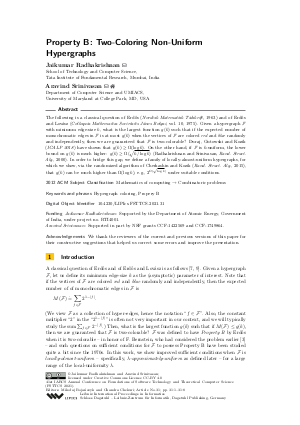Property B: Two-Coloring Non-Uniform Hypergraphs
Authors Jaikumar Radhakrishnan, Aravind Srinivasan
-
Part of:
Volume:
41st IARCS Annual Conference on Foundations of Software Technology and Theoretical Computer Science (FSTTCS 2021)
Part of: Series: Leibniz International Proceedings in Informatics (LIPIcs)
Part of: Conference: IARCS Annual Conference on Foundations of Software Technology and Theoretical Computer Science (FSTTCS) - License:
 Creative Commons Attribution 4.0 International license
Creative Commons Attribution 4.0 International license
- Publication Date: 2021-11-29
File

PDF
LIPIcs.FSTTCS.2021.31.pdf
- Filesize: 0.54 MB
- 8 pages
Document Identifiers
Subject Classification
ACM Subject Classification
- Mathematics of computing → Combinatoric problems
Keywords
- Hypergraph coloring
- Propery B
Metrics
- Access Statistics
-
Total Accesses (updated on a weekly basis)
0PDF Downloads0Metadata Views
Abstract
The following is a classical question of Erdős (Nordisk Matematisk Tidskrift, 1963) and of Erdős and Lovász (Colloquia Mathematica Societatis János Bolyai, vol. 10, 1975). Given a hypergraph ℱ with minimum edge-size k, what is the largest function g(k) such that if the expected number of monochromatic edges in ℱ is at most g(k) when the vertices of ℱ are colored red and blue randomly and independently, then we are guaranteed that ℱ is two-colorable? Duraj, Gutowski and Kozik (ICALP 2018) have shown that g(k) ≥ Ω(log k). On the other hand, if ℱ is k-uniform, the lower bound on g(k) is much higher: g(k) ≥ Ω(√{k / log k}) (Radhakrishnan and Srinivasan, Rand. Struct. Alg., 2000). In order to bridge this gap, we define a family of locally-almost-uniform hypergraphs, for which we show, via the randomized algorithm of Cherkashin and Kozik (Rand. Struct. Alg., 2015), that g(k) can be much higher than Ω(log k), e.g., 2^Ω(√{log k}) under suitable conditions.
Cite As Get BibTex
Jaikumar Radhakrishnan and Aravind Srinivasan. Property B: Two-Coloring Non-Uniform Hypergraphs. In 41st IARCS Annual Conference on Foundations of Software Technology and Theoretical Computer Science (FSTTCS 2021). Leibniz International Proceedings in Informatics (LIPIcs), Volume 213, pp. 31:1-31:8, Schloss Dagstuhl – Leibniz-Zentrum für Informatik (2021)
https://doi.org/10.4230/LIPIcs.FSTTCS.2021.31
BibTex
@InProceedings{radhakrishnan_et_al:LIPIcs.FSTTCS.2021.31,
author = {Radhakrishnan, Jaikumar and Srinivasan, Aravind},
title = {{Property B: Two-Coloring Non-Uniform Hypergraphs}},
booktitle = {41st IARCS Annual Conference on Foundations of Software Technology and Theoretical Computer Science (FSTTCS 2021)},
pages = {31:1--31:8},
series = {Leibniz International Proceedings in Informatics (LIPIcs)},
ISBN = {978-3-95977-215-0},
ISSN = {1868-8969},
year = {2021},
volume = {213},
editor = {Boja\'{n}czyk, Miko{\l}aj and Chekuri, Chandra},
publisher = {Schloss Dagstuhl -- Leibniz-Zentrum f{\"u}r Informatik},
address = {Dagstuhl, Germany},
URL = {https://drops.dagstuhl.de/entities/document/10.4230/LIPIcs.FSTTCS.2021.31},
URN = {urn:nbn:de:0030-drops-155428},
doi = {10.4230/LIPIcs.FSTTCS.2021.31},
annote = {Keywords: Hypergraph coloring, Propery B}
}
Author Details
- School of Technology and Computer Science, Tata Institute of Fundamental Research, Mumbai, India
Funding
- Radhakrishnan, Jaikumar: Supported by the Department of Atomic Energy, Government of India, under project no. RTI4001.
- Srinivasan, Aravind: Supported in part by NSF grants CCF-1422569 and CCF-1749864.
Acknowledgements
We thank the reviewers of the current and previous versions of this paper for their constructive suggestions that helped us correct some errors and improve the presentation.
References
- Dimitris Achlioptas, Jeong Han Kim, Michael Krivelevich, and Prasad Tetali. Two-coloring random hypergraphs. Random Struct. Algorithms, 20(2):249-259, 2002. URL: https://doi.org/10.1002/rsa.997.
-
J. Beck. On 3-chromatic hypergraphs. Discrete Mathematics, 24:127-137, 1978.

-
F. Bernstein. Zur Theorie der trigonometrische Reihen. Leipz. Ber., 60:325-328, 1908.

- Amey Bhangale. Np-hardness of coloring 2-colorable hypergraph with poly-logarithmically many colors. In Ioannis Chatzigiannakis, Christos Kaklamanis, Dániel Marx, and Donald Sannella, editors, 45th International Colloquium on Automata, Languages, and Programming, ICALP 2018, July 9-13, 2018, Prague, Czech Republic, volume 107 of LIPIcs, pages 15:1-15:11. Schloss Dagstuhl - Leibniz-Zentrum für Informatik, 2018. URL: https://doi.org/10.4230/LIPIcs.ICALP.2018.15.
- Danila D. Cherkashin and Jakub Kozik. A note on random greedy coloring of uniform hypergraphs. Random Struct. Algorithms, 47(3):407-413, 2015. URL: https://doi.org/10.1002/rsa.20556.
- Lech Duraj, Grzegorz Gutowski, and Jakub Kozik. A note on two-colorability of nonuniform hypergraphs. In Ioannis Chatzigiannakis, Christos Kaklamanis, Dániel Marx, and Donald Sannella, editors, 45th International Colloquium on Automata, Languages, and Programming, ICALP 2018, July 9-13, 2018, Prague, Czech Republic, volume 107 of LIPIcs, pages 46:1-46:13. Schloss Dagstuhl - Leibniz-Zentrum für Informatik, 2018. URL: https://doi.org/10.4230/LIPIcs.ICALP.2018.46.
-
P. Erdős. On a combinatorial problem, I. Nordisk Matematisk Tidskrift, 11:5-10, 1963.

-
P. Erdős. On a combinatorial problem, II. Acta Mathematica of the Hungarian Academy of Sciences, 15:445-447, 1964.

-
P. Erdős and L. Lovász. Problems and results on 3-chromatic hypergraphs and some related questions. In Infinite and finite sets (Colloq., Keszthely, 1973; dedicated to P. Erdős on his 60th birthday), volume II, pages 609-627. North-Holland, Amsterdam, 1975. Volume 10 of Colloquia Mathematica Societatis János Bolyai.

- Jaikumar Radhakrishnan and Aravind Srinivasan. Improved bounds and algorithms for hypergraph 2-coloring. Random Struct. Algorithms, 16(1):4-32, 2000. URL: https://doi.org/10.1002/(SICI)1098-2418(200001)16:1%3C4::AID-RSA2%3E3.0.CO;2-2.
- Dmitry A. Shabanov. Around erdős-lovász problem on colorings of non-uniform hypergraphs. Discret. Math., 338(11):1976-1981, 2015. URL: https://doi.org/10.1016/j.disc.2015.04.017.
